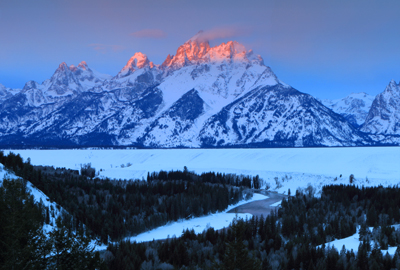“Bad weather always looks worse through a window.†– Tom Lehrer.
My friend Justin and I sat in the dark in my Ford Expedition with the motor running and the heater on. We were parked at the Snake River Overlook in Grand Teton National Park. The pullout had been plowed, but beyond the parking lot the snow was at least knee deep. It was still dark, but the overcast eastern sky was reluctantly beginning to reveal signs of dawn. It had been cloudy and snowing since we pulled into Jackson two days earlier. In the dim light we could see the base of the familiar mountains, but the majority of their elevation remained stubbornly hidden by persistent clouds that hadn’t moved since our arrival. Our photographic prospects seemed dim, and we bantered about whether it had even been a good idea to leave the comfort of the condo where our families still slumbered. I knew from the clock I should get out and get set up to take some pictures. But I believed it wouldn’t be a productive effort this morning. Subconsciously my thoughts gravitated towards reasons to stay in the warm vehicle. To add to my lack of enthusiasm, I had gone to bed the night before without installing the panoramic head on my tripod. Now I would have to assemble the bulky apparatus outside in the cold. I thought through the rest of the procedure that awaited; level the tripod, adjust the camera position, set up the click stops for the right overlap, center the series on the right spot, mount the ND grad filter – well you get the picture – all things that I love unless there’s no chance of actually using the gear once it’s ready. And with the cloud cover it just didn’t seem like it would be worth the effort.
Finally I acknowledged a nagging notion in the back of my mind, which was warning me that if I didn’t get set up soon I would risk being surprised by an unlikely break in the clouds. I confessed to Justin that I had been surprised by situations like this before, and I didn’t want to repeat that experience. So with little optimism I stepped out into the cold and began my set-up ritual. The temperature was about 12 degrees, but once I was outside I felt more motivated. The cold felt good on my face. Looking to the east I realized that I may have lingered too long in the vehicle and hurried to prepare my equipment. The mountains were still capped with clouds bu the base was beginning to clear. The eastern clouds were turning fire red, but the west was still dark and unpromising. Motivated by the intensifying glow I hurried over the knee-deep snow, occasionally falling through the crust up to my knees. I found the spot that would frame as much of the river bend as possible in the foreground. I hastily leveled the tripod and oriented the camera. Just as I attached my cable release the peak of the Grand Teton cleared the clouds and alpenglow bathed the summit. The bright, warm colors instantly dispelled all cold and inconvenience. As the radiance intensified, so did the exhilaration. Remembering my camera I eagerly began shooting, rotating the camera after each image. I soon had two series of five shots.
And then it was gone. Before I could start a third pass, the sunlight faded into the shadows and the peak of the Grand disappeared back behind the dark clouds. The spectacle had lasted about ninety seconds.
I stood silent for a time hoping for a resurgence of the sunlight, but it was soon evident that there would be no more sun on the mountains that morning. As we walked back to the warmth of the Expedition, we philosophized whether it had been worth all of the morning’s effort just for a ninety second light show. But we both knew we would be there the next time, just to see what wonder nature would unexpectedly serve up. After all, what memory would we have if we had still been lying in bed asleep?
View Snake River Overlook in a larger map



